climate control Alfa Romeo 166 2006 Owner handbook (in English)
[x] Cancel search | Manufacturer: ALFA ROMEO, Model Year: 2006, Model line: 166, Model: Alfa Romeo 166 2006Pages: 272, PDF Size: 4.17 MB
Page 87 of 272
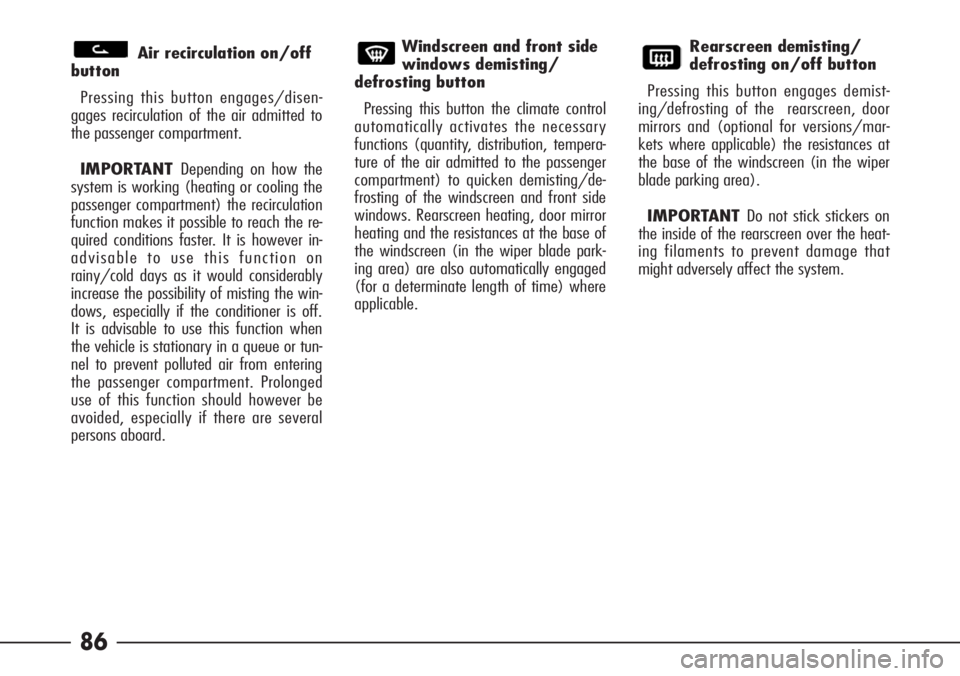
86
Air recirculation on/off
button
Pressing this button engages/disen-
gages recirculation of the air admitted to
the passenger compartment.
IMPORTANT Depending on how the
system is working (heating or cooling the
passenger compartment) the recirculation
function makes it possible to reach the re-
quired conditions faster. It is however in-
advisable to use this function on
rainy/cold days as it would considerably
increase the possibility of misting the win-
dows, especially if the conditioner is off.
It is advisable to use this function when
the vehicle is stationary in a queue or tun-
nel to prevent polluted air from entering
the passenger compartment. Prolonged
use of this function should however be
avoided, especially if there are several
persons aboard.Windscreen and front side
windows demisting/
defrosting button
Pressing this button the climate control
automatically activates the necessary
functions (quantity, distribution, tempera-
ture of the air admitted to the passenger
compartment) to quicken demisting/de-
frosting of the windscreen and front side
windows. Rearscreen heating, door mirror
heating and the resistances at the base of
the windscreen (in the wiper blade park-
ing area) are also automatically engaged
(for a determinate length of time) where
applicable.Rearscreen demisting/
defrosting on/off button
Pressing this button engages demist-
ing/defrosting of the rearscreen, door
mirrors and (optional for versions/mar-
kets where applicable) the resistances at
the base of the windscreen (in the wiper
blade parking area).
IMPORTANT Do not stick stickers on
the inside of the rearscreen over the heat-
ing filaments to prevent damage that
might adversely affect the system.
Page 88 of 272
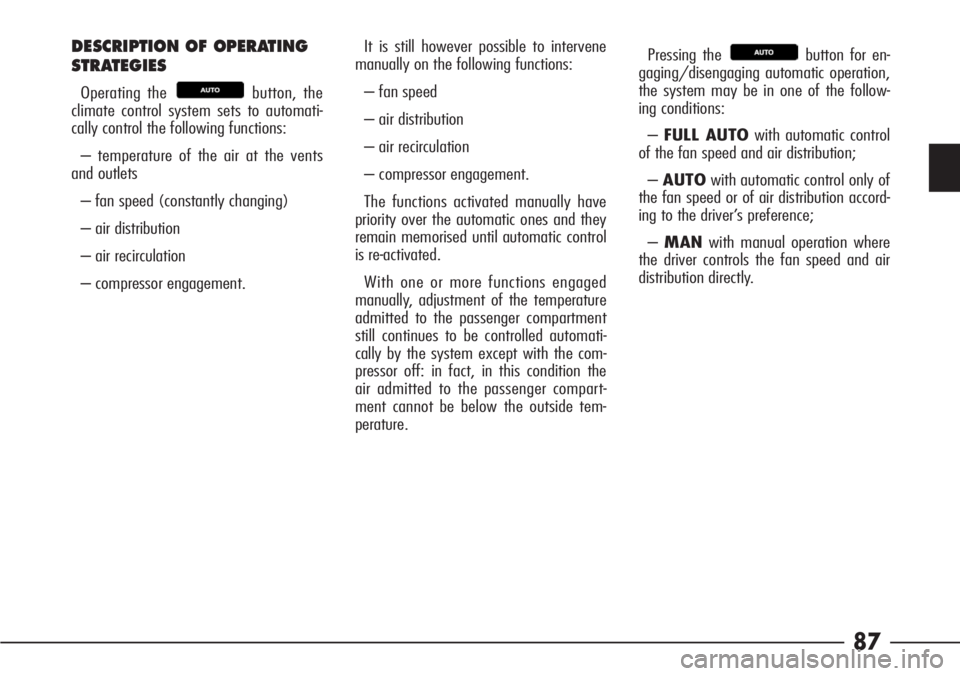
87
DESCRIPTION OF OPERATING
STRATEGIES
Operating the button, the
climate control system sets to automati-
cally control the following functions:
– temperature of the air at the vents
and outlets
– fan speed (constantly changing)
– air distribution
– air recirculation
– compressor engagement.
It is still however possible to intervene
manually on the following functions:
– fan speed
– air distribution
– air recirculation
– compressor engagement.
The functions activated manually have
priority over the automatic ones and they
remain memorised until automatic control
is re-activated.
With one or more functions engaged
manually, adjustment of the temperature
admitted to the passenger compartment
still continues to be controlled automati-
cally by the system except with the com-
pressor off: in fact, in this condition the
air admitted to the passenger compart-
ment cannot be below the outside tem-
perature.Pressing the button for en-
gaging/disengaging automatic operation,
the system may be in one of the follow-
ing conditions:
–FULL AUTOwith automatic control
of the fan speed and air distribution;
–AUTOwith automatic control only of
the fan speed or of air distribution accord-
ing to the driver’s preference;
–MANwith manual operation where
the driver controls the fan speed and air
distribution directly.
Page 89 of 272

88
Pressing the button turns
the compressor on/off. With the com-
pressor off, the air admitted to the pas-
senger compartment can not be cooled or
dehumidified and recirculation is switched
off automatically to avoid misting the
windows: when wanting to activate recir-
culation in the condition, press the corre-
sponding button.
Pressing the button again
with the compressor off, will restore the
operating conditions of before the com-
pressor was turned off.
Pressing the button turns
off/back on the climate control, in the
former case air is no longer admitted to
the passenger compartment which is thus
isolated from outside, in the latter, the
previous operating mode is restored.Pressing the button selects
the possible air distributions to the pas-
senger compartment:
Flow of air towards the windscreen
and front side windows
Distribution of the flow between
the windscreen /front side windows and
lower part of the passenger compartment
Flow of air to the lower part of the
passenger compartment and secondary
flow of air towards the windscreen and
front side windows
Distribution of the flow between
the upper centre, centre, side and rear
outlets and the lower part of the passen-
ger compartment
Flow of air towards the centre up-
per vent, centre and side dashboard out-
lets and rear outlets.If the system was in the FULL AUTO
mode, pressing the button
passes to the simple automatism condi-
tion: i.e. the system chooses the fan
speed and mixing to obtain the equiva-
lent temperature required, but will not
change the distribution selected manually.
Pressing the recirculation button
, the system automatically reac-
tivates the compressor if it was deactivat-
ed manually; to maintain recirculation
with the compressor of, it is necessary to
press the button to deacti-
vate the compressor.
Page 90 of 272
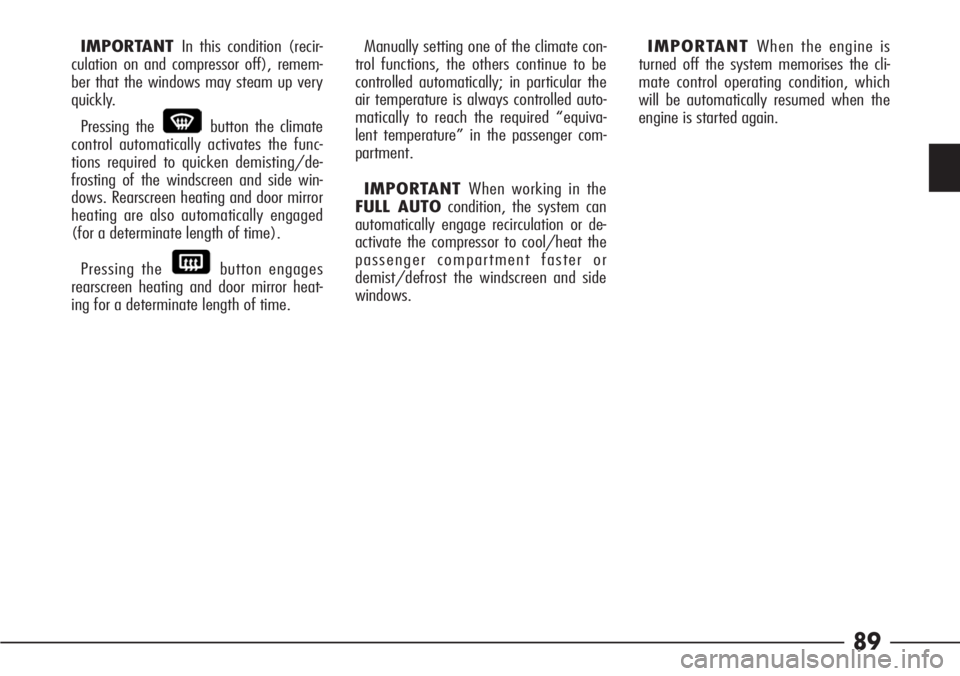
89
IMPORTANT In this condition (recir-
culation on and compressor off), remem-
ber that the windows may steam up very
quickly.
Pressing the button the climate
control automatically activates the func-
tions required to quicken demisting/de-
frosting of the windscreen and side win-
dows. Rearscreen heating and door mirror
heating are also automatically engaged
(for a determinate length of time).
Pressing the button engages
rearscreen heating and door mirror heat-
ing for a determinate length of time.Manually setting one of the climate con-
trol functions, the others continue to be
controlled automatically; in particular the
air temperature is always controlled auto-
matically to reach the required “equiva-
lent temperature” in the passenger com-
partment.
IMPORTANT When working in the
FULL AUTOcondition, the system can
automatically engage recirculation or de-
activate the compressor to cool/heat the
passenger compartment faster or
demist/defrost the windscreen and side
windows.IMPORTANT When the engine is
turned off the system memorises the cli-
mate control operating condition, which
will be automatically resumed when the
engine is started again.
Page 91 of 272
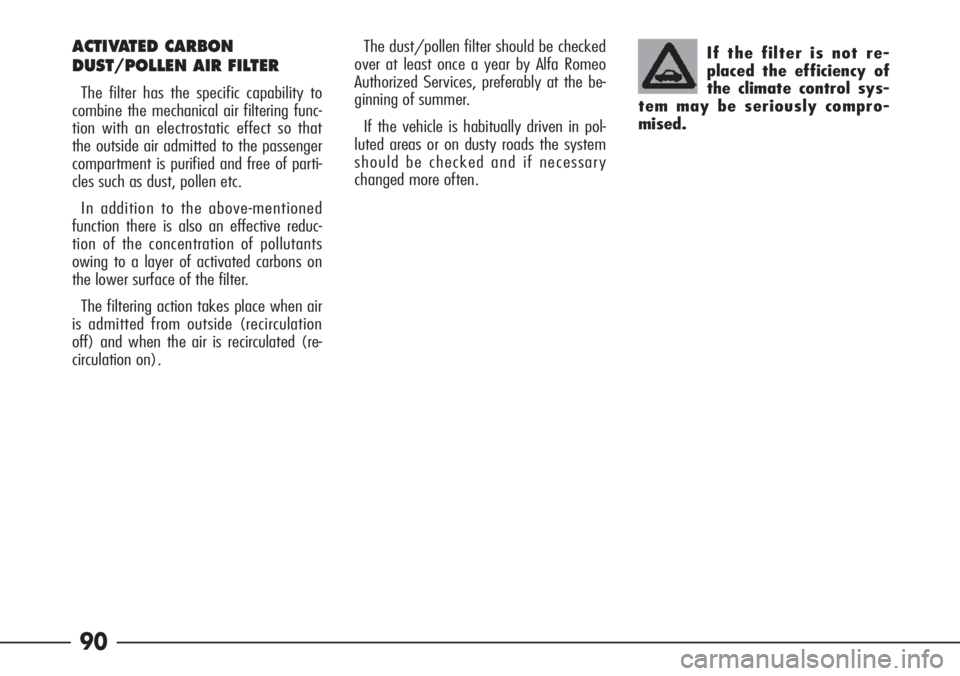
90
The dust/pollen filter should be checked
over at least once a year by Alfa Romeo
Authorized Services, preferably at the be-
ginning of summer.
If the vehicle is habitually driven in pol-
luted areas or on dusty roads the system
should be checked and if necessary
changed more often.If the filter is not re-
placed the efficiency of
the climate control sys-
tem may be seriously compro-
mised.ACTIVATED CARBON
DUST/POLLEN AIR FILTER
The filter has the specific capability to
combine the mechanical air filtering func-
tion with an electrostatic effect so that
the outside air admitted to the passenger
compartment is purified and free of parti-
cles such as dust, pollen etc.
In addition to the above-mentioned
function there is also an effective reduc-
tion of the concentration of pollutants
owing to a layer of activated carbons on
the lower surface of the filter.
The filtering action takes place when air
is admitted from outside (recirculation
off) and when the air is recirculated (re-
circulation on).
Page 138 of 272
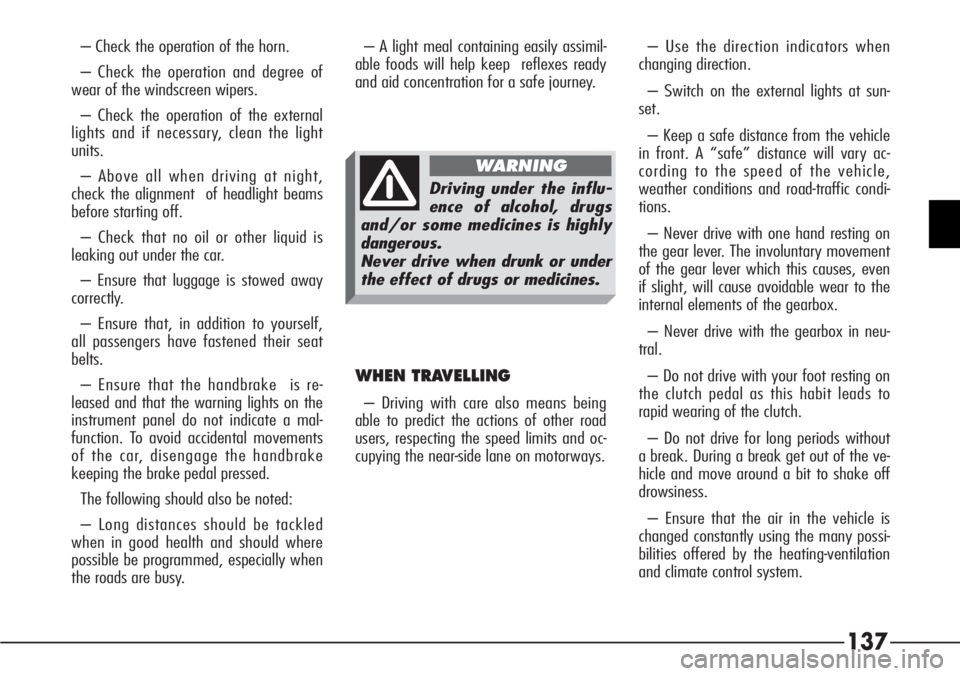
137
– Check the operation of the horn.
– Check the operation and degree of
wear of the windscreen wipers.
– Check the operation of the external
lights and if necessary, clean the light
units.
– Above all when driving at night,
check the alignment of headlight beams
before starting off.
– Check that no oil or other liquid is
leaking out under the car.
– Ensure that luggage is stowed away
correctly.
– Ensure that, in addition to yourself,
all passengers have fastened their seat
belts.
– Ensure that the handbrake is re-
leased and that the warning lights on the
instrument panel do not indicate a mal-
function. To avoid accidental movements
of the car, disengage the handbrake
keeping the brake pedal pressed.
The following should also be noted:
– Long distances should be tackled
when in good health and should where
possible be programmed, especially when
the roads are busy.– A light meal containing easily assimil-
able foods will help keep reflexes ready
and aid concentration for a safe journey.– Use the direction indicators when
changing direction.
– Switch on the external lights at sun-
set.
– Keep a safe distance from the vehicle
in front. A “safe” distance will vary ac-
cording to the speed of the vehicle,
weather conditions and road-traffic condi-
tions.
– Never drive with one hand resting on
the gear lever. The involuntary movement
of the gear lever which this causes, even
if slight, will cause avoidable wear to the
internal elements of the gearbox.
– Never drive with the gearbox in neu-
tral.
– Do not drive with your foot resting on
the clutch pedal as this habit leads to
rapid wearing of the clutch.
– Do not drive for long periods without
a break. During a break get out of the ve-
hicle and move around a bit to shake off
drowsiness.
– Ensure that the air in the vehicle is
changed constantly using the many possi-
bilities offered by the heating-ventilation
and climate control system.
WHEN TRAVELLING
– Driving with care also means being
able to predict the actions of other road
users, respecting the speed limits and oc-
cupying the near-side lane on motorways.
Driving under the influ-
ence of alcohol, drugs
and/or some medicines is highly
dangerous.
Never drive when drunk or under
the effect of drugs or medicines.
WARNING
Page 150 of 272
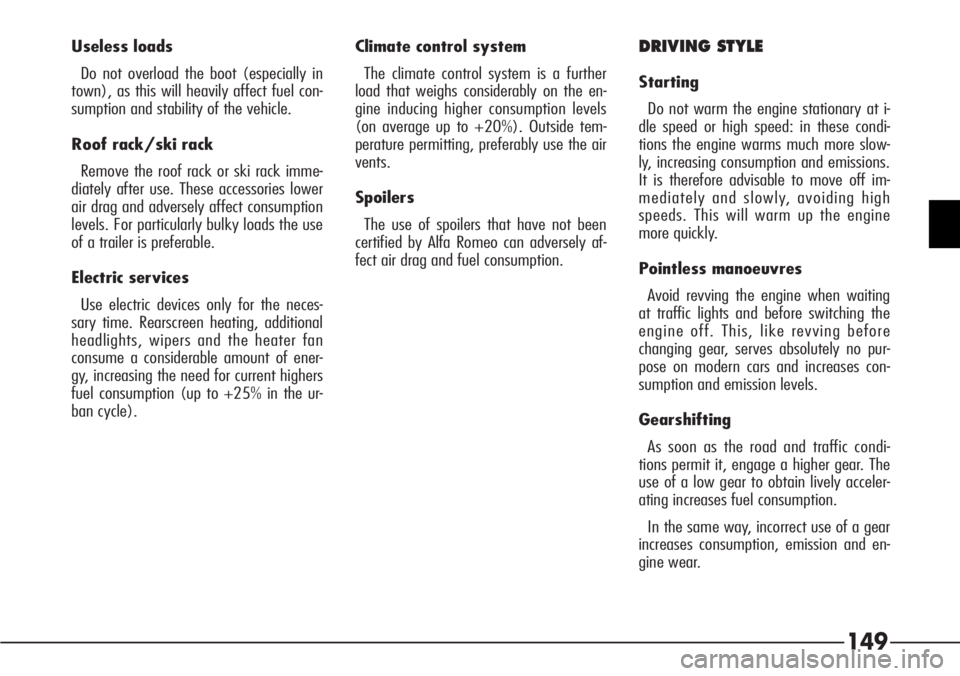
149
Useless loads
Do not overload the boot (especially in
town), as this will heavily affect fuel con-
sumption and stability of the vehicle.
Roof rack/ski rack
Remove the roof rack or ski rack imme-
diately after use. These accessories lower
air drag and adversely affect consumption
levels. For particularly bulky loads the use
of a trailer is preferable.
Electric services
Use electric devices only for the neces-
sary time. Rearscreen heating, additional
headlights, wipers and the heater fan
consume a considerable amount of ener-
gy, increasing the need for current highers
fuel consumption (up to +25% in the ur-
ban cycle).Climate control system
The climate control system is a further
load that weighs considerably on the en-
gine inducing higher consumption levels
(on average up to +20%). Outside tem-
perature permitting, preferably use the air
vents.
Spoilers
The use of spoilers that have not been
certified by Alfa Romeo can adversely af-
fect air drag and fuel consumption.DRIVING STYLE
Starting
Do not warm the engine stationary at i-
dle speed or high speed: in these condi-
tions the engine warms much more slow-
ly, increasing consumption and emissions.
It is therefore advisable to move off im-
mediately and slowly, avoiding high
speeds. This will warm up the engine
more quickly.
Pointless manoeuvres
Avoid revving the engine when waiting
at traffic lights and before switching the
engine off. This, like revving before
changing gear, serves absolutely no pur-
pose on modern cars and increases con-
sumption and emission levels.
Gearshifting
As soon as the road and traffic condi-
tions permit it, engage a higher gear. The
use of a low gear to obtain lively acceler-
ating increases fuel consumption.
In the same way, incorrect use of a gear
increases consumption, emission and en-
gine wear.
Page 190 of 272
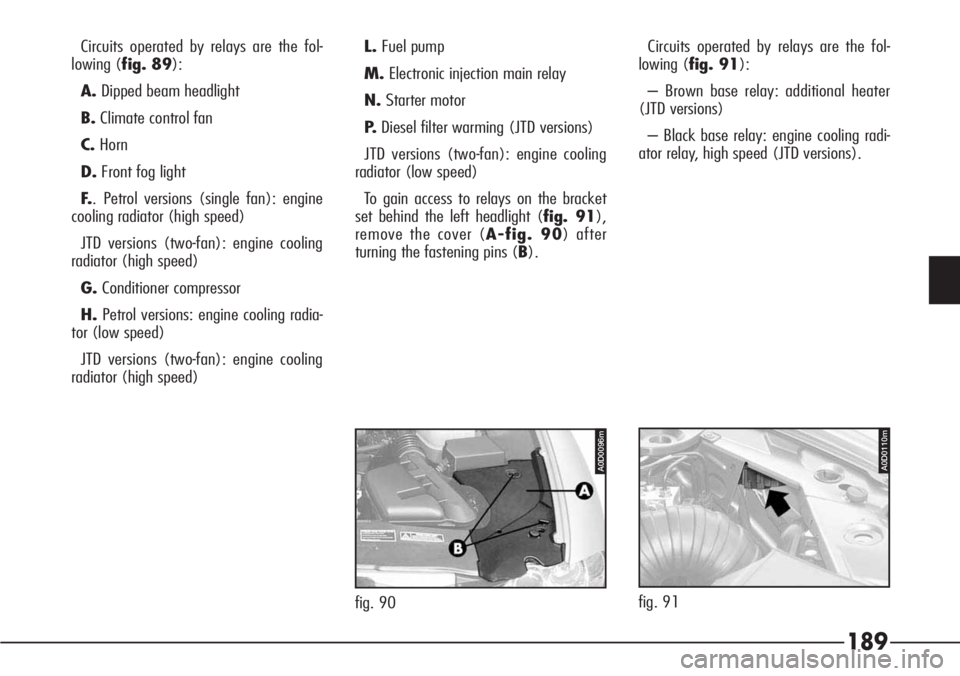
189
Circuits operated by relays are the fol-
lowing (fig. 89):
A.Dipped beam headlight
B.Climate control fan
C.Horn
D.Front fog light
F.. Petrol versions (single fan): engine
cooling radiator (high speed)
JTD versions (two-fan): engine cooling
radiator (high speed)
G.Conditioner compressor
H.Petrol versions: engine cooling radia-
tor (low speed)
JTD versions (two-fan): engine cooling
radiator (high speed)L.Fuel pump
M.Electronic injection main relay
N.Starter motor
P.Diesel filter warming (JTD versions)
JTD versions (two-fan): engine cooling
radiator (low speed)
To gain access to relays on the bracket
set behind the left headlight (fig. 91),
remove the cover (A-fig. 90) after
turning the fastening pins (B).Circuits operated by relays are the fol-
lowing (fig. 91):
– Brown base relay: additional heater
(JTD versions)
– Black base relay: engine cooling radi-
ator relay, high speed (JTD versions).
A0D0096m
fig. 90
A0D0110m
fig. 91
Page 191 of 272
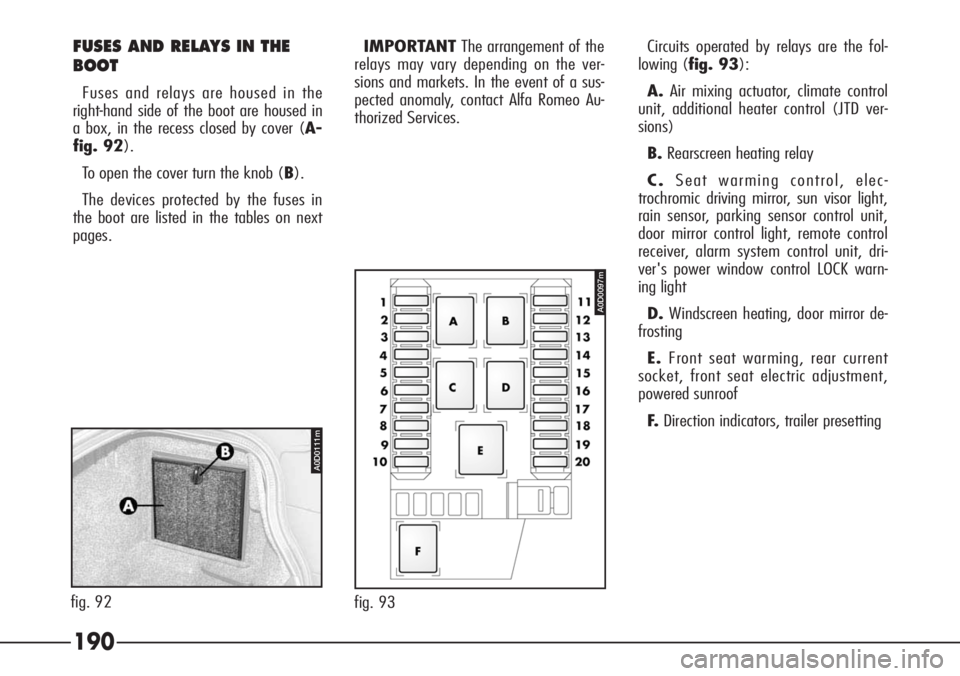
190
FUSES AND RELAYS IN THE
BOOT
Fuses and relays are housed in the
right-hand side of the boot are housed in
a box, in the recess closed by cover (A-
fig. 92).
To open the cover turn the knob (B).
The devices protected by the fuses in
the boot are listed in the tables on next
pages.IMPORTANTThe arrangement of the
relays may vary depending on the ver-
sions and markets. In the event of a sus-
pected anomaly, contact Alfa Romeo Au-
thorized Services.Circuits operated by relays are the fol-
lowing (fig. 93):
A.Air mixing actuator, climate control
unit, additional heater control (JTD ver-
sions)
B.Rearscreen heating relay
C.Seat warming control, elec-
trochromic driving mirror, sun visor light,
rain sensor, parking sensor control unit,
door mirror control light, remote control
receiver, alarm system control unit, dri-
ver's power window control LOCK warn-
ing light
D.Windscreen heating, door mirror de-
frosting
E.Front seat warming, rear current
socket, front seat electric adjustment,
powered sunroof
F.Direction indicators, trailer presetting
518PGS
fig. 93
A0D0097m
A0D0111m
fig. 92
Page 192 of 272
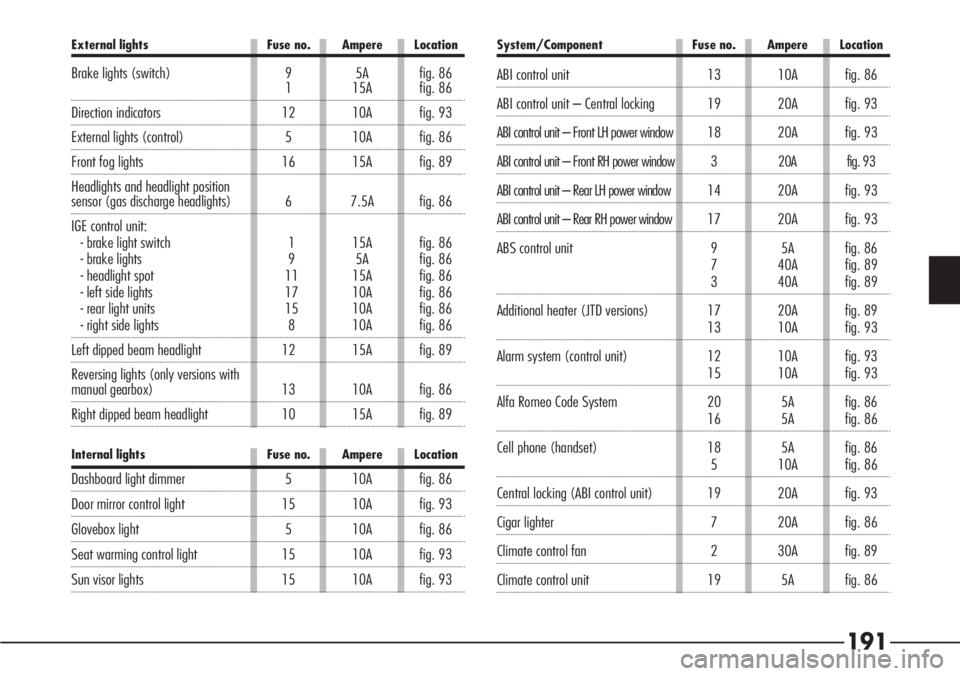
191
System/Component Fuse no. Ampere Location
ABI control unit 13 10A fig. 86
ABI control unit – Central locking 19 20A fig. 93
ABI control unit – Front LH power window 18 20Afig. 93
ABI control unit – Front RH power window 3 20A fig. 93
ABI control unit – Rear LH power window 14 20Afig. 93
ABI control unit – Rear RH power window 17 20Afig. 93
ABS control unit 9 5A fig. 86
7 40A fig. 89
3 40A fig. 89
Additional heater (JTD versions) 17 20A fig. 89
13 10A fig. 93
Alarm system (control unit) 12 10A fig. 93
15 10A fig. 93
Alfa Romeo Code System 20 5A fig. 86
16 5A fig. 86
Cell phone (handset) 18 5A fig. 86
5 10A fig. 86
Central locking (ABI control unit) 19 20A fig. 93
Cigar lighter 7 20A fig. 86
Climate control fan 2 30A fig. 89
Climate control unit 19 5A fig. 86
External lights Fuse no. Ampere Location
Brake lights (switch) 9 5A fig. 861 15A fig. 86
Direction indicators 12 10A fig. 93
External lights (control) 5 10A fig. 86
Front fog lights 16 15A fig. 89
Headlights and headlight position
sensor (gas discharge headlights) 6 7.5A fig. 86
IGE control unit:
- brake light switch 1 15A fig. 86
- brake lights 9 5A fig. 86
- headlight spot 11 15A fig. 86
- left side lights 17 10A fig. 86
- rear light units 15 10A fig. 86
- right side lights 8 10A fig. 86
Left dipped beam headlight 12 15A fig. 89
Reversing lights (only versions with
manual gearbox) 13 10A fig. 86
Right dipped beam headlight 10 15A fig. 89
Internal lights Fuse no. Ampere Location
Dashboard light dimmer 5 10A fig. 86
Door mirror control light 15 10A fig. 93
Glovebox light 5 10A fig. 86
Seat warming control light 15 10A fig. 93
Sun visor lights 15 10A fig. 93